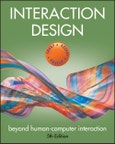A new edition of the #1 text in the human computer Interaction field!
Hugely popular with students and professionals alike, the Fifth Edition of Interaction Design is an ideal resource for learning the interdisciplinary skills needed for interaction design, human-computer interaction, information design, web design, and ubiquitous computing. New to the fifth edition: a chapter on data at scale, which covers developments in the emerging fields of 'human data interaction' and data analytics. The chapter demonstrates the many ways organizations manipulate, analyze, and act upon the masses of data being collected with regards to human digital and physical behaviors, the environment, and society at large.
Revised and updated throughout, this edition offers a cross-disciplinary, practical, and process-oriented, state-of-the-art introduction to the field, showing not just what principles ought to apply to interaction design, but crucially how they can be applied.
- Explains how to use design and evaluation techniques for developing successful interactive technologies
- Demonstrates, through many examples, the cognitive, social and affective issues that underpin the design of these technologies
- Provides thought-provoking design dilemmas and interviews with expert designers and researchers
- Uses a strong pedagogical format to foster understanding and enjoyment
An accompanying website contains extensive additional teaching and learning material including slides for each chapter, comments on chapter activities, and a number of in-depth case studies written by researchers and designers.
Table of Contents
What’s Inside? xvii
1 What is Interaction Design? 1
1.1 Introduction 1
1.2 Good and Poor Design 2
1.3 What is Interaction Design? 9
1.4 The User Experience 13
1.5 Understanding Users 15
1.6 Accessibility and Inclusiveness 17
1.7 Usability and User Experience Goals 19
Interview with Harry Brignull 34
2 The Process of Interaction Design 37
2.1 Introduction 37
2.2 What is Involved in Interaction Design? 38
2.3 Some Practical Issues 55
3 Conceptualizing Interaction 69
3.1 Introduction 69
3.2 Conceptualizing Interaction 71
3.3 Conceptual Models 74
3.4 Interface Metaphors 78
3.5 Interaction Types 81
3.6 Paradigms, Visions, Theories, Models, and Frameworks 88
Interview with Albrecht Schmidt 97
4 Cognitive Aspects 101
4.1 Introduction 101
4.2 What is Cognition? 102
4.3 Cognitive Frameworks 123
5 Social Interaction 135
5.1 Introduction 135
5.2 Being Social 136
5.3 Face-to-Face Conversations 139
5.4 Remote Conversations 143
5.5 Co-presence 150
5.6 Social Engagement 158
6 Emotional Interaction 165
6.1 Introduction 165
6.2 Emotions and the User Experience 166
6.3 Expressive Interfaces and Emotional Design 172
6.4 Annoying Interfaces 174
6.5 Affective Computing and Emotional AI 179
6.6 Persuasive Technologies and Behavioral Change 182
6.7 Anthropomorphism 187
7 Interfaces 193
7.1 Introduction 193
7.2 Interface Types 194
7.3 Natural User Interfaces and Beyond 252
7.4 Which Interface? 253
Interview with Leah Buechley 257
8 Data Gathering 259
8.1 Introduction 259
8.2 Five Key Issues 260
8.3 Data Recording 266
8.4 Interviews 268
8.5 Questionnaires 278
8.6 Observation 287
8.7 Choosing and Combining Techniques 300
9 Data Analysis, Interpretation, and Presentation 307
9.1 Introduction 307
9.2 Quantitative and Qualitative 308
9.3 Basic Quantitative Analysis 311
9.4 Basic Qualitative Analysis 320
9.5 Which Kind of Analytic Framework to Use? 329
9.6 Tools to Support Data Analysis 341
9.7 Interpreting and Presenting the Findings 342
10 Data at Scale 349
10.1 Introduction 349
10.2 Approaches to Collecting and Analyzing Data 351
10.3 Visualizing and Exploring Data 366
10.4 Ethical Design Concerns 375
11 Discovering Requirements 385
11.1 Introduction 385
11.2 What, How, and Why? 386
11.3 What Are Requirements? 387
11.4 Data Gathering for Requirements 395
11.5 Bringing Requirements to Life: Personas and Scenarios 403
11.6 Capturing Interaction with Use Cases 415
Interview with Ellen Gottesdiener 418
12 Design, Prototyping, and Construction 421
12.1 Introduction 421
12.2 Prototyping 422
12.3 Conceptual Design 434
12.4 Concrete Design 445
12.5 Generating Prototypes 447
12.6 Construction 457
Interview with Jon Froehlich 466
13 Interaction Design in Practice 471
13.1 Introduction 471
13.2 AgileUX 473
13.3 Design Patterns 484
13.4 Open Source Resources 489
13.5 Tools for Interaction Design 491
14 Introducing Evaluation 495
14.1 Introduction 495
14.2 The Why, What, Where, and When of Evaluation 496
14.3 Types of Evaluation 500
14.4 Evaluation Case Studies 507
14.5 What Did We Learn from the Case Studies? 514
14.6 Other Issues to Consider When Doing Evaluation 516
15 Evaluation Studies: From Controlled to Natural Settings 523
15.1 Introduction 523
15.2 Usability Testing 524
15.3 Conducting Experiments 533
15.4 Field Studies 536
Interview with danah boyd 546
16 Evaluation: Inspections, Analytics, and Models 549
16.1 Introduction 549
16.2 Inspections: Heuristic Evaluation and Walk-Throughs 550
16.3 Analytics and A/B Testing 567
16.4 Predictive Models 576
References 581
Index 619








